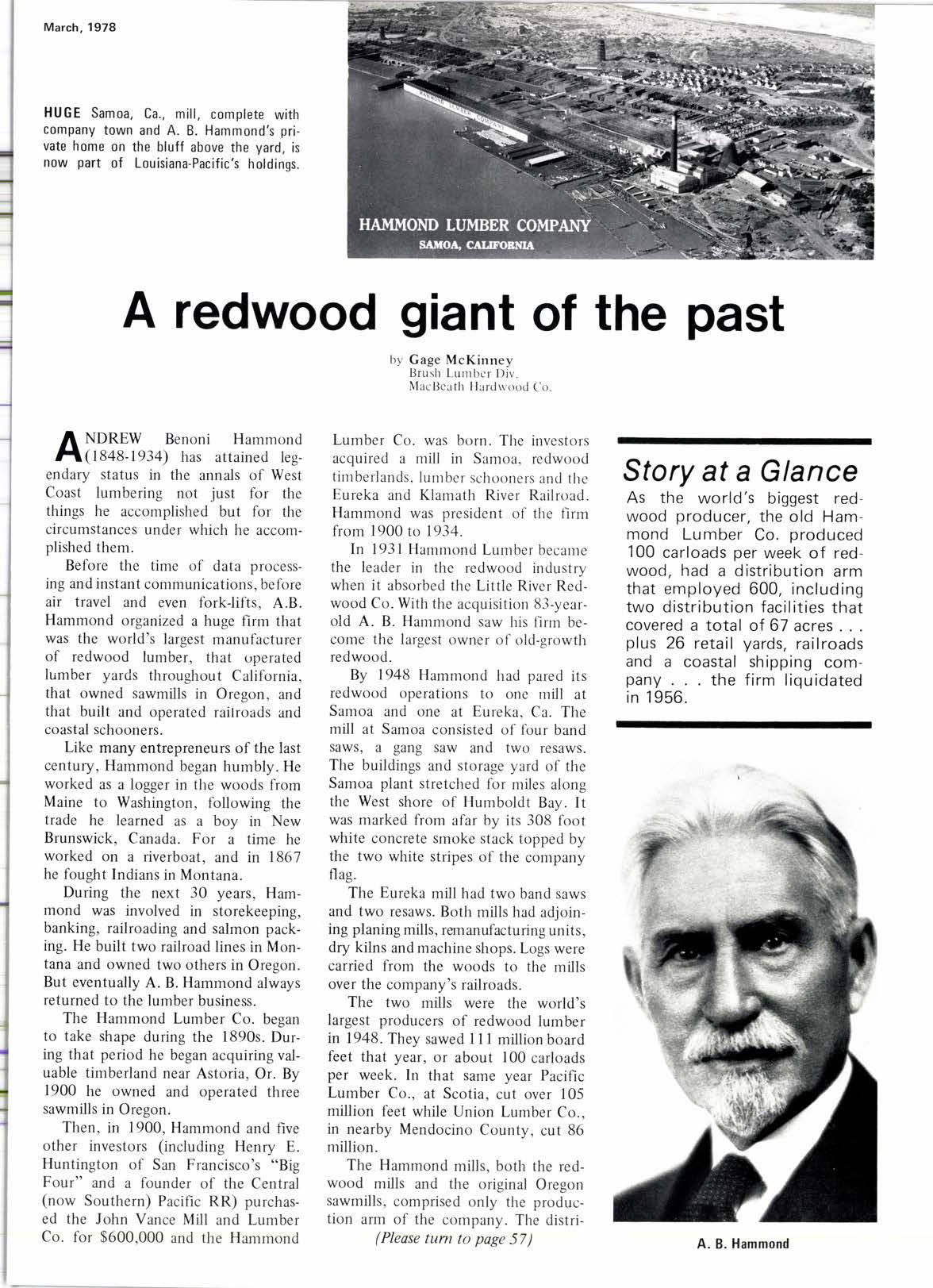
2 minute read
A redwood giant of the past
by Gage McKinney Brush Lutnbcr l)iv. Macllcrth llardrvood ('o.
n NDREW Benoni Hammond
/rrA ( I 848- I 934) has atrained legendary status in the annals of West Coast lumbering not just for the things he accomplished but for the circumstances under which he accomplished them.
Before the time of data processing and instant communications, before air travel and even fork-lifts, A.B. Hammond organized a huge firm that was the world's largest manufacturer of redwood lumber, that operated lumber yards throughout California, that owned sawmills in Oregon, and that built and operated raiiroads and coastal schooners.
Like many entrepreneurs of the last century, Hammond began humbly. He worked as a logger in the woods from Maine to Washington, following the trade he learned as a boy in New Brunswick, Canada. For a time he worked on a riverboat, and in 1867 he fought Indians in Montana.
During the next 30 years, Hammond was involved in storekeeping, banking, railroading and salmon packing. He built two railroad lines in Montana and owned two others in Oregon. But eventually A. B. Hammond always returned to the lumber business.
The Hammond Lumber Co. began to take shape during the 1890s. During that period he began acquiring valuable timberland near Astoria, Or. By 1900 he owned and operated three sawmills in Oregon.
Then, in 1900, Hammond and five other investors (including Henry E. Huntington of San Francisco's "Big Four" and a founder of the Central (now Southern) Pacific RR) purchased the John Vance Mill and Lumber Co. for $600,000 and the Hammond
Lumber Co. was born. The investors acquired a mill in Samoa, redwood tirnberlands. lurnber schooners and the Eureka and Klamath River Railroad. Hammond was president of the firm from 1900 to 1934.
In 193 1 Hamrnond Luntber becanre the leader in the redwood industry when it absorbed the Little River Redwood Co. With the acquisition 83-yearold A. B. Hammond saw his firm become the largest owner of old-growth redwood.
By 1948 Hammond had pared its redwood operations to one rnill at Samoa and one at Eureka, Ca. The mill at Samoa consisted of four band saws, a gang saw and two resaws. The buildings and storage yard of the Samoa plant stretched for miles along the West shore of Humboldt Bay. It was marked from afar by its 308 foot white concrete smoke stack topped by the two white stripes of the company flag.
The Eureka mill had two band saws and two resaws. Both mills had adjoining planing mills, remanufacturing units, dry kilns and machine shops. Logs were carried from the woods to the mills over the company's railroads.
The two mills were the world's largest producers of redwood lumber in 1948. They sawed l l l million board feet that year, or about 100 carloads per week. In that same year Pacific Lumber Co., at Scotia, cut over 105 million feet while Union Lumber Co., in nearby Mendocino County, cut 86 million.
The Hammond mills, both the redwood mills and the original Oregon sawmills, comprised only the production arm of the company. The distri(Pleose tum to page 57 )
Story at a Glance
As the world's biggest redwood producer, the old Hammond Lumber Co. produced 100 carloads per week of redwood, had a distribution arm that employed 600, including two distribution facilities that covered a total of 67 acres . plus 26 retail yards, railroads and a coastal shipping company the firm liquidated in 1956.










